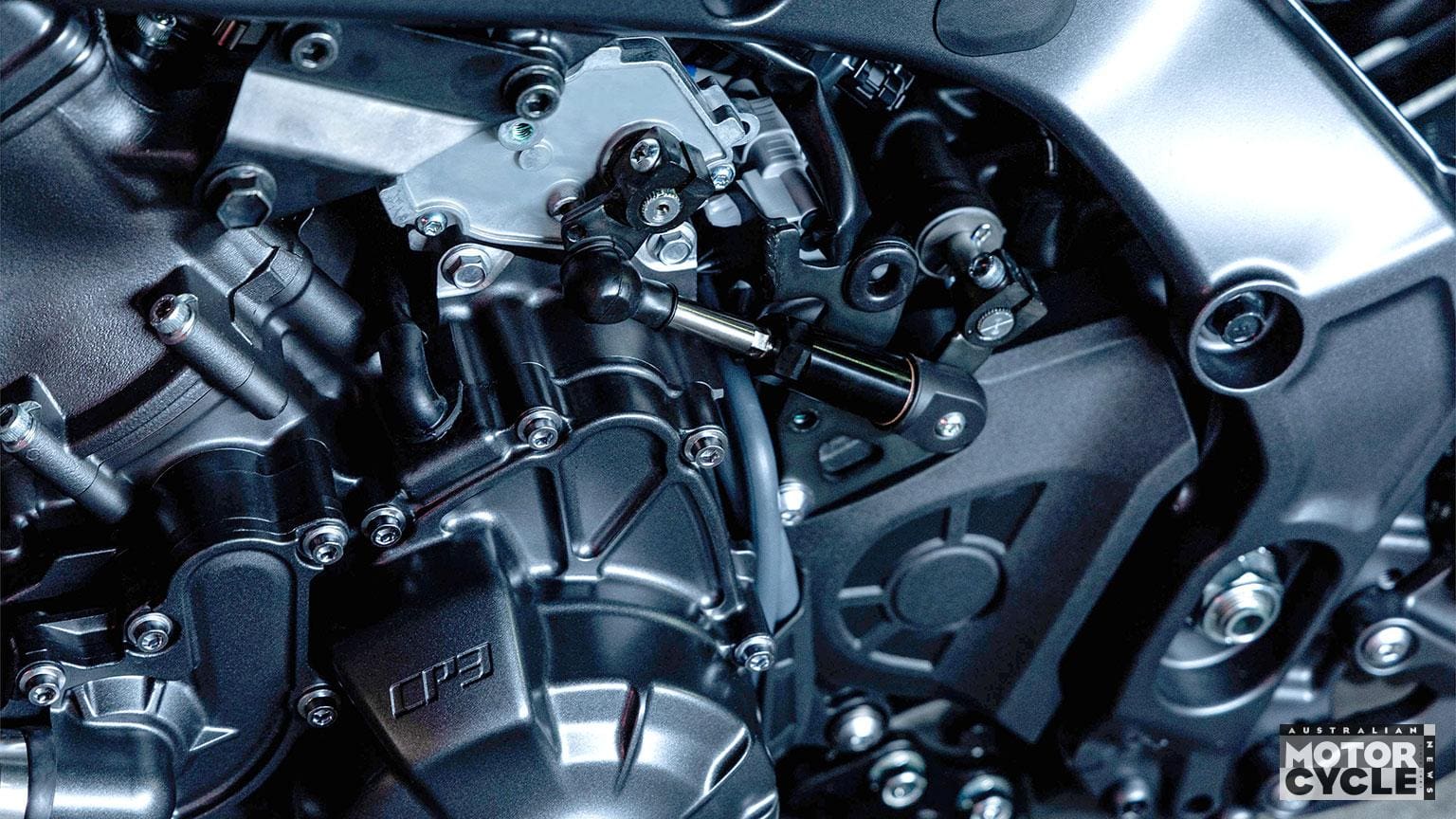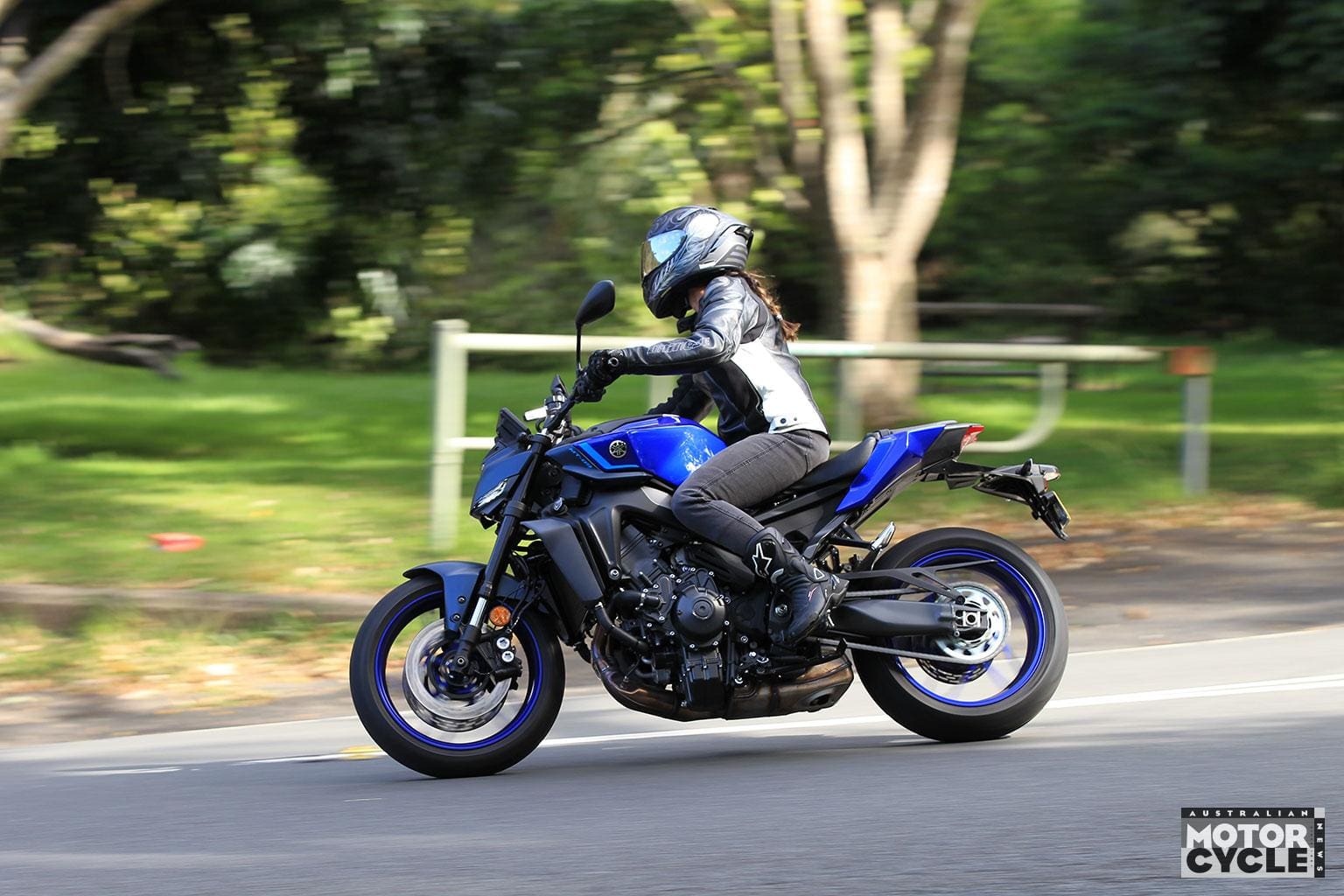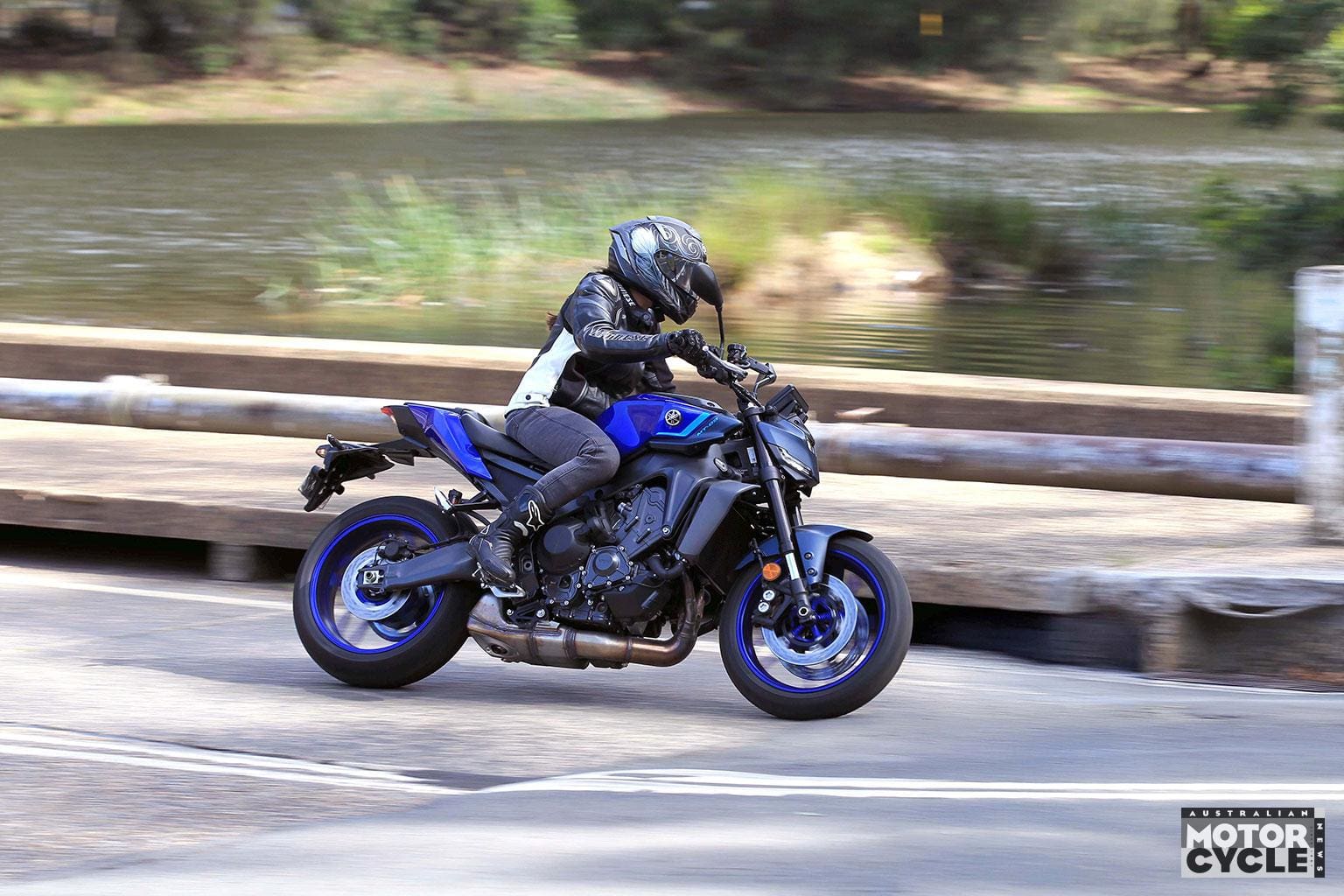Yamaha’s new MT-09 Y-AMT has arrived, and it’s packed with so much tech your left hand will wonder why it’s out of a job.
There’s a small primal thrill that comes with the simple act of shifting gears on a motorcycle – an ancient connection between machine and rider. Yamaha’s latest technical release aims to offer riders the option of experiencing that thrill or simply enjoying a semi-automated relaxed ride.
Yamaha’s long-running MT-09 naked is a great example of the connection that can be made between man and machine. Designed for practical sports riding, it offers an agile, performance-driven experience. Now, with the introduction of the Yamaha Automated Manual Transmission (Y-AMT) on the latest MT-09, that experience is being transformed. But will it deliver a better riding experience?
Your brain can be a strange thing (well, mine is). I can jump onto a scooter with an auto CVT transmission, handlebar-mounted front and rear brake levers, a seat that’s more like a barstool, flat board instead of ’pegs and scoot off into the distance. My brain knows it’s a scooter and adjusts itself accordingly. However, when I jumped onto the new MT-09 Y-AMT without a clutch lever on the left-hand ’bar or gear shifter at my right foot, it created neurological chaos. My brain had registered “motorcycle”, and decades of muscle memory meant my left hand and left foot began to twitch because there was nothing for them to do.

Riding off on the MT-09 Y-AMT for the first time, I had a strange sensation I’d forgotten something, the feeling caused by the loss of tasks for my fingers and toes. While Yamaha’s clutchless MT-09 automatic transmission motorcycle is a brilliant piece of tech, it does take a bit of getting used to. I was amazed at how many times my fingers instinctively flinched for the clutch lever and my toes searched for the gear selector, especially when slowing down in traffic. Once the confusion in my brain died down, I discovered that Yamaha’s Y-AMT system delivers an extremely laidback ride without the loss of any of a typical MT-09’s sporty characteristics thanks to the choice of full automatic or clutchless manual with flappy-paddle shifting. As the first Yamaha model to feature the next-gen Y-AMT transmission technology, the MT-09 Y-AMT is looking to rewrite the rulebook on sport riding. Imagine the same torque-laden, adrenaline-fuelled performance you know and love from Yamaha’s iconic CP3 engine, but with the added versatility of both manual and fully automatic transmission modes.
The MT-09 has been reviewed in this magazine many times since its introduction a decade ago, so the real story here is not so much the bike – though it would be impossible to test this bike and not provide my personal feelings. It’s about the technology delivered in Yamaha’s new transmission and whether or not it’s a game-changer, or the answer to a question that was not being asked.

How the tech works
Yamaha’s first foray into automated shifting on a sport motorcycle, Y-AMT offers a seamless blend of manual quickshifting, for a traditional sports bike feel, and automatic transmission convenience. According to Yamaha, it’s been designed to enhance the sport riding experience while empowering the rider with the choice between full control and effortless ease.
Choosing between AT (automatic) and MT (manual) transmissions is done via an index-finger-actuated button on the right-hand switch block, roughly where the high beam flasher switch usually is on the left-handlebar. This can be done at any time (with the throttle closed) so you can easily change the bike to adapt to the prevailing road conditions or your mood.
About now, you may be wondering if I’ve forgotten that I earlier mentioned that the MT-09 Y-AMT does not possess a clutch lever or a foot-operated gear shifter, so how can it have manual shift capabilities without these two vital components? That’s a great question and I’m glad you asked it.
The manual mode uses a finger-operated see-saw lever beneath the left handlebar switch block to control gear changes. Shifting is via a clutchless quickshifter-style system, and the clever automatic clutch actuator lets you stop and start in the same way you would in any modern car that uses a clutchless manual gearbox – no need to search for neutral. Neutral can be selected if desired but, unlike a conventional bike, it’s located below first gear and cannot accidentally be selected while the bike is moving.

The clutch of the Y-AMT system is not a centrifugal type; the inner workings of the gearbox are the same as the standard model, and Yamaha claims a weight increase of just 2.8kg over the standard model to accommodate two electric motors (actuators) in the gearbox – one for gear changes and one to work the clutch. The two actuators literally take clutch duties and gearshift duties out of the hands – and feet – of the rider.
While not having a clutch lever and foot-operated gear selector does do your head in a bit, shifting gears via the handlebar-mounted gear selector is intuitive and fast. Remember the first time you rode a bike with a quickshifter? That’s how fast you’ll adapt to the fingertip gear changer. Simply use the thumb and index finger of your left hand to flick through the gears. If you’re feeling extra sporty you can also insert your index finger between the up and down paddles for one-finger gearshifts. Whatever you choose, the system allows for incredibly quick gearshifts, perfect for sport riding or anytime you don’t feel like giving full control of gearchange decisions to the motorcycle’s electronic brain. Riding a bike like the MT-09 is all about delivering a sporty and exhilarating ride. Having a paddle-shift lever for manual gear changing does it in spades. Do I prefer it more than a foot-operated gear shifter? I think it’s a tie – for now.
Yamaha’s line on the system is that it’s all about keeping the rider focused on what really matters – throttle control, lean angle and grip – and it’s hard to disagree. Yamaha says the Y-AMT system keeps the rider locked into the moment: “Every twist of the throttle is met with heightening excitement, allowing you to push the limits of Yamaha’s iconic CP3 engine.” No mention of wheelstand capabilities though!

top-selling models
When and how to use the system
For those times when you just want to sit back and enjoy the ride, the MT-09 Y-AMT offers two automatic transmission modes: D and D+.
The D mode is perfect for urban riding, with softer, more relaxed gear shifts that are ideal for commuting or cruising around town. It’s smooth, easy-going and takes the pressure off when you’re navigating thick traffic or simply enjoying a laidback ride.
For more spirited riding, the D+ mode keeps the engine in the power band for longer, delaying upshifts to maintain higher revs and deliver a sportier, more engaging ride.
AT mode is pure set-and-forget. The bike’s electronic wizardry calculates the optimum up and down gearchange point based on speed and revs. While the actuator in the gearbox does make a bit of noise, I can confirm that the gearshifts are smooth in operation.
At lower speeds, such as lane filtering and when coming to a stop, the Y-AMT system also looks after clutch operation (as it does in MT mode), leaving you to free to navigate the traffic. I struggled with this at first because I like to modulate my lane filtering speed via the clutch, however the way the clutch is gently engaged in conjunction with the ride-by-wire throttle made filtering smooth and simple. As soon as you’re free of the congestion, a twist of the throttle delivers instant and uninterrupted power to the rear wheel, with none of the lag that can be experienced with a centrifugal clutch.

After spending a solid week riding the new MT-09 Y-AMT I understand what Yamaha is trying to achieve. It has delivered some interesting tech that will no doubt be seen on other Yamaha models in the future. It could even be the start of a new chapter in sport riding.
While it does take a few rides to get used to, once your brain has it worked out there’s a nice balance between manual and automatic shifting, offering the best of both worlds.
The MT-09 Y-AMT offers all the thrills of the standard MT-09, but with an added layer of versatility. The beauty of Yamaha’s Y-AMT system lies not just in its technical innovation but in how it’s broadening the riding experience. At one end it’s a more relaxed ride, thanks to the elimination of the clutch lever and foot shifter; at the other end the MT-09 Y-AMT adds an extra element of sportiness – much like when flappy paddles arrived on the sportscar scene.

What’s so great about the new system?
There’s a lot to like about Yamaha’s new Y-AMT system and, while I first wondered why Yamaha did not debut it on a LAMS model (see breakout), I soon realised that the best way to show off the capabilities of Y-AMT is to fit it to one of its most popular and sporty bikes. In addition to some cool tech, you also get lightning-fast getaways and zero chance of stalling.
Manual mode keeps you as engaged as a conventional gear shift system, with the added bonus of a relaxed ride when you’re feeling like letting the bike take on some of the work.
But one aspect of the system had me a bit flummoxed. When the automatic transmission is activated and holding a steady low-speed pace in a low gear the sportier D+ mode can be a bit undecided on what gear it wants to be in, switching back and forth between two.
You know those time when you accelerate in second gear, then flick to third and at the same time you throttle off so you don’t get lifted out of your seat by engine braking? The Y-AMT system does not understand this idea because it’s not your brain. So, if you accelerate hard in second gear and let off the throttle it will stay in second gear and even click into first when the speed drops low enough. Having the system sometimes change gears halfway through a roundabout or around a corner (in D or D+ mode) also take a bit of getting used to. There’s no chance of a mid-corner gear change leading to an incident, it’s just something you wouldn’t normally do.

Things I discovered that are different to a conventional motorcycle
If you stop and turn off the bike while in gear, you can’t move (no clutch). You need to start the engine and select neutral. So, if your key fob is in the house and you need to wheel your bike out of the way in the garage, you will be heading back into the house to get that fob.
Neutral is located below first gear. However, it can’t be accidentally selected while riding.
Once started, you cannot engage first gear while the sidestand is down. However the bike will start in gear with the clutch automatically engaged, so don’t give the throttle a twist until you are ready to depart.
If you start the bike with the key fob in range, you can ride off into the distance and leave the key fob behind. You will not realise your error until you stop to take pics (or similar) 45 minutes from your starting point!
In manual mode the system will automatically drop down the gears to first as you come to a stop. However, it will not upshift, it will only bounce off the rev-limiter.
You can override the automatic gear changing with the manual gear-selector – up and down.
The Sport, Street, Rain and Custom modes can be selected on the fly while in manual mode via the Mode switch. In Automatic mode the selections are D and D+.

It’s still an MT-09 and that’s a good thing
Other than the loss of a clutch lever and foot-operated gear shifter, all the other elements that have made the MT-09 a popular naked bike remain unchanged from the recently upgraded current model. Powered by the same 890cc, three-cylinder CP3 engine that delivers 87.5kW (117hp) at 10,000rpm and 92Nm of torque, the MT-09 pulls hard from low revs and keeps delivering as you wind it out no matter what variant you choose to own. The feeling of power delivery is amplified by air intake ducts that deliver an invigorating induction roar.
Ergonomically, the MT-09/SP/Y-AMT variants offer a riding position that feels natural and comfortable while intuitively connecting rider with machine. The handlebar and footpegs are adjustable, and the two-part seat adds comfort for longer rides, while the Smart Key System makes starting the bike and accessing the fuel tank a keyless experience. Call me a bit old-fashioned, but I prefer my ignition keys to be safely stored in an ignition barrel. I’ve never understood the idea behind keyless bikes. Cars, yes. Bikes? They’re just waiting for a lost/left-behind fob disaster to unfold – as I discovered.
Having said that, there’s no doubt that the Y-AMT system has claimed a place in the future of motorcycling.

The future of automatics
As manufacturers continue to innovate, the future of automatic motorcycles looks interesting. Numerous brands are exploring new automated systems and upcoming models are expected to incorporate more sophisticated technologies that blend traditional riding with modern automation. While the allure of manual shifting remains strong among purists, automatic transmissions are carving out their niche within the motorcycle community in the same way DCT systems in cars have seen the decline of the traditional stick shift. For new riders it will make the joy of the two-wheeled lifestyle more accessible by removing the complexities of manual gear changes.
Automatic transmissions in motorcycles
While automatic gearboxes have been a staple in cars for decades, their adoption in motorcycles has been slower – much slower. However, advancements in technology are paving the way for new models such as Yamaha’s Y-AMT.
Automatic transmissions in motorcycles have historically come in two forms: continuously variable transmission (CVT) and dual-clutch transmission (DCT).
CVTs are commonly found in scooters and smaller bikes, allowing for smooth acceleration without the effort of traditional gear shifting.
In contrast, DCTs offer a more sophisticated approach, utilising two clutches to pre-select gears for seamless shifts without the need for a clutch lever. The DCT system debuted with Honda’s VFR1200F in 2010.
Several other bikes (scooters excluded) have integrated automatic transmissions over the years

• Honda CB750A (1976-1978): Often considered the first automatic motorcycle, the CB750A featured a two-speed torque converter system. Despite its innovative design, it struggled commercially but laid the groundwork for future developments decades later.
• Yamaha FJR1300AS (2006): This sport-touring bike introduced Yamaha’s YCC-S (Yamaha Chip-Controlled Shift), which allowed for semi-automatic gear changes without a traditional clutch lever. Riders could change gears using a handlebar switch, blending automation with rider engagement.
• Honda DN-01 (2008): A unique fusion of cruiser and scooter aesthetics, the DN-01 employed Honda’s Human Friendly Transmission (HFT), offering three modes: automatic, sport and manual.
• Honda Goldwing DCT: Honda’s interstate tourer offers an optional DCT catering to riders seeking both luxury and riding ease.
• Honda Africa Twin DCT: This adventure bike combines rugged performance with Honda’s transmission technology. The Africa Twin’s DCT hass multiple modes that are tailored for various terrains.
• MV Agusta Turismo Veloce RC SCS: Features a semi-automatic system that allows riders to enjoy manual control via an automated clutch engagement.
Why not an Automatic LAMS bike?
While the application of an automatic gearshift system onto entry-level motorcycles makes a lot of sense, especially with the ever-increasing number of new road users who’ve never experienced a manual gearbox, and have no desire to master one, Yamaha decided to debut the new system on a high-capacity naked sports model designed for experienced riders. According to Sean Goldhawk, Marketing Manager for Land Mobility products at Yamaha Motor Australia, they wanted to show the sporty nature of the system first: “It’s all about selling the excitement the new system can deliver. It would not have been as exciting to launch the system on an entry-level or touring bike.”
No doubt the tech boffins at Yamaha are already well advanced on fitting the system to a much wider range of models. Stay tuned.

Rider Bio – Sheena Watkins
Sheena is a laidback motoring enthusiast at heart. With 14 years of riding experience and a shed full of various bikes, her weekends usually involve riding with friends, exploring new routes, soaking in the scenery and appreciating the freedom. Keen to stay updated with the latest automotive trends, she’s always searching out new groups of fellow riders to connect with to share stories and exchange tips. For Sheena, riding is a relaxing escape that offers a sense of community and adventure, an opportunity to unwind and connect with people who share her love of the open road.











